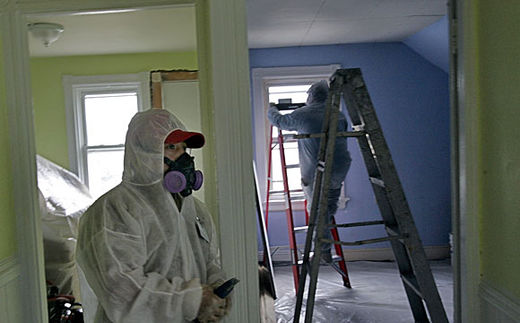
One-year-old Nelly Gomez refused to eat. Anything she swallowed, she immediately threw up.
Thinking Nelly had indigestion, her parents took her to a nearby clinic in MacArthur Park. A blood test revealed a diagnosis that surprised and worried them: lead poisoning.
"I didn't know what was going to happen," said her father, Nelson Gomez, an unemployed construction worker. "As her dad, I felt desperate."
Despite enormous strides over the last 20 years in protecting children from lead, which can cause irreversible nerve and brain damage, health workers still find unsafe levels in thousands of California youths every year.
Now the number of cases could climb dramatically based on emerging research of the harm associated with low levels of the metal in children's systems. At the same time, government programs to combat lead poisoning are being slashed.
"Much of the effort that has been put into educating the public, and particularly the communities that are the most vulnerable ... will fade because there won't be enough prevention," said Hilary Godwin, a professor at UCLA's School of Public Health who has studied lead poisoning.
The problem remains most persistent in low-income neighborhoods, where families like Nelly's live in aging apartment buildings with peeling lead paint or other hazards. An inspector found lead on the window frames and a door in the family's apartment, Gomez said.
Two decades have passed since federal officials sounded the alarm on childhood lead poisoning, calling it the nation's top environmental health threat.
Laws banning lead in paint, gasoline and other products have sharply reduced the danger. The number of young children with elevated lead levels dropped from 4.4% in 1991 to 0.6% in 2006, according to the U.S. Centers for Disease Control and Prevention. Still, the metal is commonly found in old paint and dirt, as well as in jewelry, toys, candy and home remedies.
"So many products have lead in them," said Maurice Pantoja, chief environmental health specialist for the county's lead prevention program. "Lead is all around us."
Health officials are giving renewed attention to the threat. For the first time since 1991, the CDC is considering lowering the lead level considered safe for children. Currently, the agency says 10 micrograms of lead per deciliter of blood is considered elevated. But in light of research showing damage to children with lower levels, an expert advisory panel wants the cutoff dropped to 5 micrograms.
If adopted, the number of children under age 6 requiring assistance could jump from 250,000 to 450,000 nationwide.
But budget pressures have reduced money to combat the problem. Congress this year cut more than 90% of the federal government's lead poisoning prevention program, leaving just $2 million nationwide. Los Angeles County alone lost $660,000.
As it is, state and county officials said they have to prioritize delivery of services to children with the highest lead levels, using the CDC's guidelines.
In California, 21,692 children under age 6 tested positive for elevated lead levels in 2010. But only 2,035 qualified for assistance, which typically includes a visit by a public nurse and an environmental inspector and follow-up testing. In L.A. County, health workers found 6,453 young children with lead in their blood, but only about 562 qualified for services.
"We don't have the resources to do more," said Angie Toyota, director of the Childhood Lead Poisoning Prevention Program for the county health department.
Children under 6 are most at risk for lead poisoning because they put more things in their mouths. Even at low levels, poisoning can cause lower IQs, learning disabilities and behavioral problems. Higher levels can cause organ problems or even coma.
Many cases go undiagnosed because the symptoms are hidden or children aren't tested. Not all pediatricians consider lead as a possible cause when a child is sick.
"There are many cases that are going under the radar, where children are not getting diagnosed and the environment is not getting cleaned up," said Perry Gottesfeld, a member of the CDC's lead poisoning advisory panel.
California requires doctors to test young children on Medi-Cal and other public safety-net programs, but state officials acknowledge that only about 60% of all low-income children are being screened.
The state remains committed to testing children and educating parents, said Valerie Charlton, head of the state's lead poisoning prevention program.
Charlton said the state is assessing what it would cost to provide services to more children if the CDC lowers its lead threshold. "We would like to extend that care to other children ... but a lot of this is extremely resource-intensive," she said.



Reader Comments
to our Newsletter